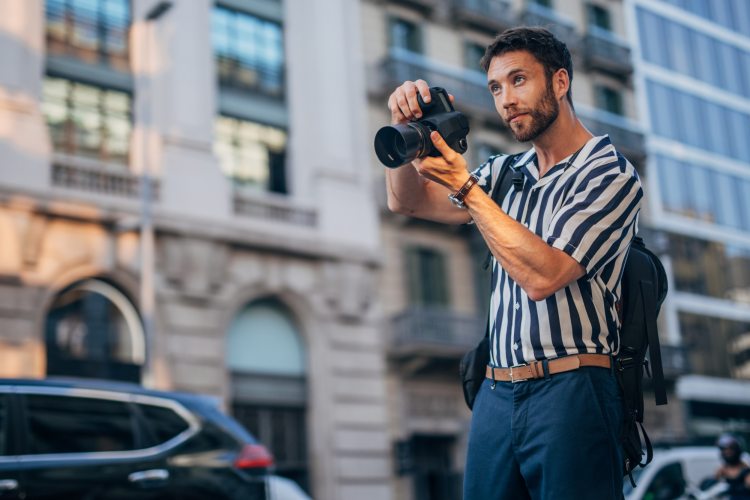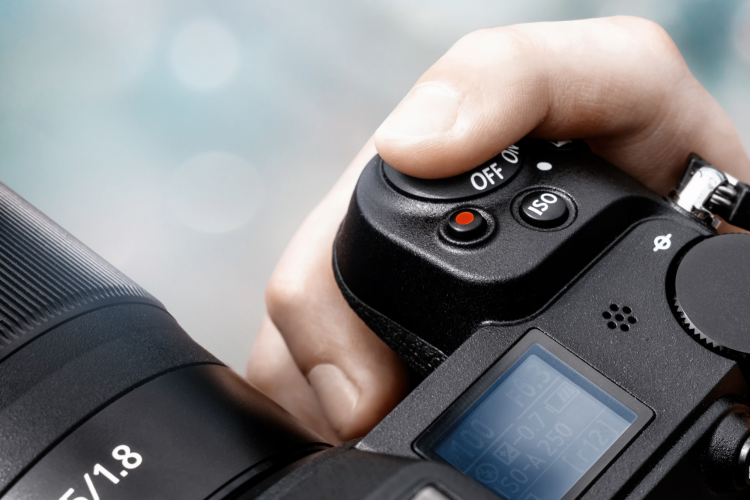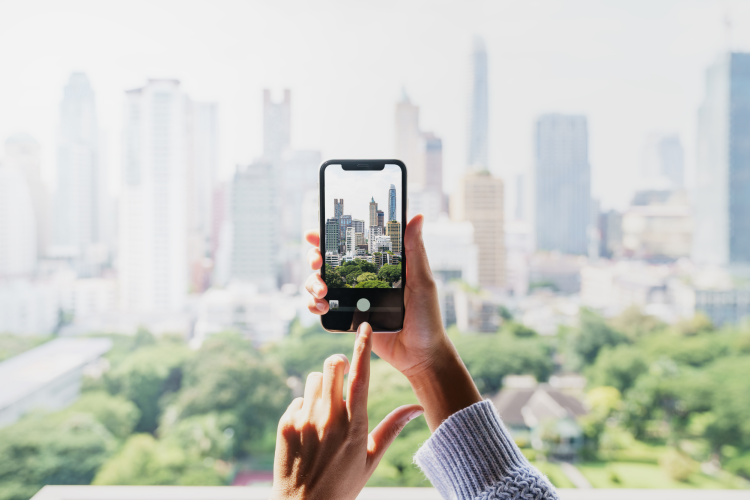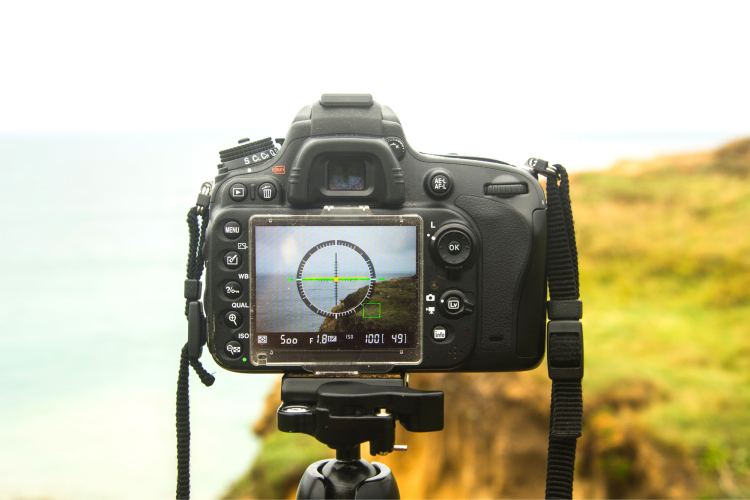Photography 101: Learn Photography for Beginners With Ease

Are you searching for opportunities to learn photography for beginners? Do you want to be able to capture stunning, professional photos? If you aren’t sure how to get into photography, know that it is a lot simpler than it seems.
Whether for your career or as a creative hobby, taking good pictures is an invaluable skill to have in today’s world, and it’s one that will help you stand out from the ever-increasing crowd of amateur photographers. Not to mention studies at Georgia Southern University claim that engaging in artistic activities can help improve memory and brain function!
When you learn photography for beginners, it should be enjoyable. It's a valuable skill that you can carry with you throughout your life, and we're here to help you get off on the right foot. Let's get started!
Jump to Section
- Photography Classes for Beginners
- How Can I Teach Myself Photography?
- Five Basics for Learning Photography for Beginners
- Learn Photography for Beginners With a Phone
- Learn Photography for Beginners With a DSLR
- Types of Photography
- Photography Tips for Beginners
Photography Classes for Beginners
When you’re searching for courses to help you learn photography for beginners, you may come across classes that pertain to photographers who already know the basics. To avoid confusion or getting lost in unfamiliar terminology, it’s best to start with classes for novices, like a film photography or digital photography for beginners course.
Find a Photography Mentor or Instructor
When first learning photography for beginners, there are certainly myriad new concepts to understand and techniques to perfect, and oftentimes these are best understood when taught by a knowledgeable photographer.
To learn photography for beginners, starting by consulting an experienced instructor is always a safe route. While you can experiment on your own and do research, learning photography for beginners can be a very complex and in-depth practice that can also get a bit difficult without the help of someone who knows what they’re talking about.
There is nothing that can compare to hands-on guidance from an expert in the field. In these courses, you can learn anything from how to photograph the night sky to how to position food for great recipe shots in food photography.
Digital Photography for Beginners Courses
Photography newbies will enjoy photography classes in Los Angeles, photography classes in Houston, photography classes in Austin and other exciting photography classes near you, which offer digital photography courses tailored to beginners and are led by experienced five-star photographers.
You can also browse online photography classes to learn photography for beginners from home. In a world that shares more photographs than ever, understanding digital photography is an incredibly valuable skill to have under your belt!

How Can I Teach Myself Photography?
Don’t underestimate yourself — you can definitely teach yourself photography! If you want to learn photography for beginners on your own, you’ve simply got to do research and practice.
When people wonder how to get into photography, they often assume that it’s a difficult or overwhelming skill to learn. However, as with most new skills, learning photography for beginners is only as difficult as you make it. As long as you’re having fun and being patient, you’ll only get better with time.
Is Photography Hard to Learn?
Like most skills, photography is one that only gets better with practice. Get out there and take photos at various times of day, of various subjects and with different methods until you start to see photographs you like.
Luckily, the internet is suffused with valuable information that will make learning photography for beginners a breeze!
Where Do I Start With Photography?
So, you’re ready to self-start your journey towards learning photography for beginners. Here are a couple of great ways to introduce yourself to the art:
Get Familiar With Your Camera
Whether you’re using a smartphone or are looking to try some of the best cameras for photography, you should start by really learning how to use your device. You’ll want to become adept at holding your camera steady, and at how to adjust the lens and camera parts to enhance your images.
You don't need to get a super expensive model when first starting out, there are plenty of cheap cameras for photography out there that even professionals love using!
Explore Different Subjects
Once you know which tools you’ll primarily be using, consider the type of photographs you’d like to take. For example, do you want to be able to capture human emotion poignantly in your images with street photography? Or maybe you want to become a nature photographer and focus on flower photography.
Tip: Starting out by photographing a wide variety of subjects is the best way to sharpen your skills.

Five Basics for Learning Photography for Beginners
What Should Beginner Photographers Know?
Learning photography for beginners isn’t only about learning how to use a camera. It’s about the art of capturing whole moments within frames, obtaining good lighting, balancing colors, detecting emotion in images and more. Not all photos need to be in the realm of fine art photography, but experimentation leads to knowledge.
Of course, to do all of this, it helps to know how to hold and position a camera, which angles to shoot from, how to get the right lighting and color balance, and how all of the parts of a camera help achieve these goals.
Before you dive into your journey to learn photography for beginners, these are five photography basics for beginners that you should know:
1. Composition
The word composition comes from the word compose. As such, this term refers to how the image itself is composed within the camera frame. You might want to take a photo of a stunning flower, but the photograph will only come out great if you know how to compose the scene.
When learning photography for beginners, you will practice looking at every aspect of the image — not just the subject. You’ll learn to use certain angles, zoom settings and lighting to best position all of the elements of a photo, including the foreground (what’s closest to the camera), the background and everything in between.
2. Exposure
When anyone learns photography for beginners, the first and most important place to start is the lighting. A good photographer knows how to manipulate their camera settings and positioning to be able to capture a subject on film regardless of the real-life lighting situation.
This all starts with exposure, which is the amount of light that is exposed to the camera lens. If you’ve ever seen a photo that is extremely bright to the point where the photograph is almost out of focus, it’s probably overexposed, meaning that there is too much light in the photo. '
Likewise, a photo that is too dark is underexposed. Photographers use the “exposure triangle,” which is a method for adjusting three camera settings to perfect the image’s lighting.
The exposure triangle makes use of the camera’s aperture, which is the actual part of the camera that controls how much light passes through the lens.

3. Aperture
The aperture also controls the camera’s depth of field. Depth of field is another important term to learn photography for beginners, as it refers to the focus of the photograph in relation to how close-up or far away your subject is.
For example, a shallow depth of field means the subject of the photo is close-up. When shooting a shallow depth of field, you’d typically use a wide aperture, and a narrow aperture for landscape photography or a farther away subject.
4. ISO
To learn photography for beginners, knowing how to adjust the ISO is crucial, as the ISO is the third factor in the exposure triangle. The ISO is another aspect of the camera that affects the amount of light in an image.
A higher ISO means a brighter image, but it’s a bit more complicated than that. An image taken with the ISO too high can turn out to be grainy or low-quality.
5. Shutter
Controlling the camera’s shutter speed is one of the first important lessons in learning photography. The shutter speed is one of the three aspects of the exposure triangle, as the shutter of the camera is what actually allows the light in after the aperture is adjusted.
The aperture controls the amount of light let in, but the shutter speed dictates how long the light can pass through the lens. This might sound confusing, but understanding the relationship between the aperture and the shutter speed will become second nature with practice.
When learning photography for beginners, balancing the ISO, aperture and shutter speed is a delicate task that will become easier with guidance and practice.

Learn Photography for Beginners With a Phone
When people learn photography for beginners, they often assume that they will need to purchase a bulky, expensive professional camera. For this reason, many people shy away from getting into photography altogether.
However, there is no rule that says good photos can only be taken on expensive cameras. This statement has never been more true, as high-quality cameras become less expensive and as smartphones are being made with more and more high quality lenses.
How to Take Good Photos With a Phone
To learn photography for beginners with a phone, it matters which phone you’re working with. When it comes to having a quality phone camera, the newer the better.
Here are some photography tricks with a phone camera for beginners:
- Utilize your phone camera’s gridlines to help with image composition.
- Practice staying as still as possible, and consider using a tripod for your phone.
- Take advantage of the digital nature of cell phone photos and snap as many photos as you can (practice makes perfect!).
- Since phone cameras don’t have as advanced settings as DSLR cameras do, it’s best to take advantage of natural day lighting to take the best photos.
- Learn how to focus on your phone. All phones are different, but for most, you’d tap the screen where you want the camera to focus.
- Phone cameras don’t adjust their own lighting as well as DSLR cameras do, so learn to adjust your camera’s exposure.

Learn Photography for Beginners With a DSLR
What is a DSLR?
You might think you don’t know what a DSLR camera is, but you’ve very likely seen or even used one.
When people learn photography for beginners, they often picture large, fancy professional cameras, like the kind with really long lenses or the ones that have to be propped up on a tripod. This is more or less what a DSLR camera is.
DSLR Camera Modes and Settings
Autofocus Mode
This is most often the default mode not only for those learning photography for beginners, but also the experts! In auto or autofocus mode, your camera adjusts the aperture, ISO and shutter speed all on its own.
While you can make your own personal tweaks to the image’s lighting, having your camera on this setting is very helpful and useful, and mostly ensures that your photo will come out nice.
Every camera is different and has varied settings. Most DSLR cameras have specific settings within auto mode that can help you take quality photos in certain situations.
Most cameras have a sport mode for moving subjects, wherein the camera works to focus on the subject without blur, a setting for stationary objects and a completely automated mode, wherein the camera adjusts everything on its own.
Manual Mode
As you might have guessed, when your camera is in the manual setting, you adjust everything manually, including the aperture, shutter speed, flash and ISO. This can be kind of hard to do on your own, especially if you are learning photography for beginners. Taking quality photos in manual mode takes a lot of practice.

Metering Modes
On DSLR cameras, there are metering modes that affect how light or dark your images will turn out. These modes determine the proper settings for the shutter speed and aperture based off of the natural light of the setting that you are in.
Knowing how to select the correct metering mode will determine how light or dark your photo will come out. Every camera is different, but there is typically a default metering mode, a metering mode for portrait photography or images with a center focus, and a mode that focuses the light on your image’s focal point, which is useful for moving objects.
Focal Length
This is how far the lens of your camera can zoom and focus. There are various lenses to achieve certain photographs, like the wide-angle lens, zoom lens, telephoto lens and prime lens, all of which can achieve different focal lengths.
Once you get familiar with learning photography for beginners, you will likely work with some of these different lenses.
Types of Photography
When you learn photography for beginners, you might have an idea of what type of photography you’d like to get good at. Maybe you love capturing animals or landscapes, or perhaps you’ve always dreamed of becoming a sports photographer or capturing beautiful moments with out-of-the-box wedding photography ideas.
Each subject, setting and intention for your photographs requires their own specific lighting, positioning and camera modes, so it’s a good idea to get familiar with the various types of photography.
This is not an exhaustive list, but these are some common types of photography for those who want to learn photography for beginners. Many fall under the category of commercial photography.
Portrait
When you learn photography for beginners, portrait photography is probably one of the first kinds that you'll learn. A portrait is typically a close-up shot of one singular subject, like a person or an animal, wherein the subject is completely in focus and the background is not. Learning to adjust metering, depth of field and exposure is important for portraits.
Landscape
Nature photography is a very vast field, and it encompasses landscape photography, wildlife photography, underwater photography, aerial photography and more.
Capturing an image of a landscape wherein the sunlight might be hindered in places by clouds and there are numerous objects within the foreground and background is a complex task, which is why landscape photography is its own specialization that requires special knowledge.

Underwater
Underwater photography, like wildlife photography, takes skill and patience. You’ve also got to be comfortable with and capable of diving underwater for long periods of time, and sometimes at great depths. This is likely not the type of photography you want to start with if you are learning photography for beginners.
Sports
Sports photography is a highly competitive field (no pun intended). Taking quality images of fast-moving subjects while maintaining an ideal depth of field and focus takes tons of practice.
Editorial
When you learn photography for beginners, you’ll learn that photography can be a form of visual storytelling. Editorial or journalism photography refers to photographs that are usually used alongside news stories, and the emphasis is on being able to capture stories and emotions in images.
Still Life
Still life photos are some of the first you might take when you learn photography for beginners. Still life photos are of inanimate objects, and this photography is about optimal placement, shading and angling of objects for artful-looking images.
Wildlife
Wildlife photography takes lots of skills and patience, but if you are learning photography for beginners, you have time to develop these skills!
Capturing a wild animal in its natural habitat is difficult because, on top of worrying about lighting in tricky places like shady forests or overly-sunny fields, you’ve got to remain absolutely still and silent.
Moreover, you will likely be kind of farther away from your subject and will have to become adept at using zoom and focus settings.

Photography Tips for Beginners
Experiment (A lot!)
Of course, learning photography for beginners entails lots and lots of practice. You can read a million books on photography, but you won’t really start to learn until you’re out in the world taking pictures.
The best way to get good at photography is to experiment with your camera and your subjects. Try taking pictures in a wide variety of indoor and outdoor environments, take pictures at different times of the day during different seasons, use an array of angles, try taking pictures of fast-moving subjects, etc.
Use the Wrong Settings
To learn photography for beginners, you start by learning how to use camera settings properly. Once you understand what the settings do, it’s actually helpful to get out there and take pictures while using the settings in the wrong way, like setting the ISO super high on a sunny day. Doing this enough will help you really understand how and why certain settings work best in certain environments.
Don’t forget — while understanding how to use a camera is necessary, photography is still an art form. So, although it’s a rule of thumb that you should lower the ISO for less light, no one is telling you that your photos have to contain a specific amount of light. In other words, you are the artist, and you have a unique eye. Let that show when you use your camera!
And, remember to play around in editing software to see how you can modify and change your images to fit your particular style. Here are some amazing Canva hacks to help you get started.
Switch Up Your Perspective
This goes along with experimentation. When you learn photography for beginners, you might get into a habit of taking lots of very similar photos, as you may not have yet learned what other opportunities you have.
Use this chance to think creatively, like an artist. If you see a subject that you want to photograph, do it from an angle you didn’t originally think of. Try aerial shots, eye-level shots, capture from below or angle your camera to the side.

There has never been a better time to learn photography for beginners than while living in a time wherein people are taking more photographs than ever before. Of course, learning photography for beginners consists of lots of new terms and techniques to get used to. However, with practice, photography will become second nature and a wonderful creative outlet.
Depending on your camera and what you’d like to do with your photographs, you may need a lot more practice and guidance. Experts are always available to help you learn photography for beginners, so consider taking a photography class near you.
For even more creative ideas and inspiration, check out other experiences happening on Classpop!

